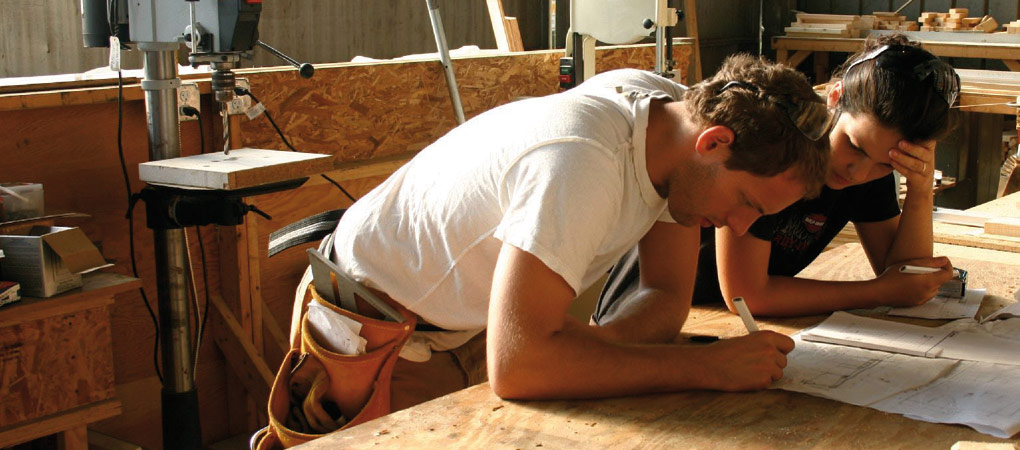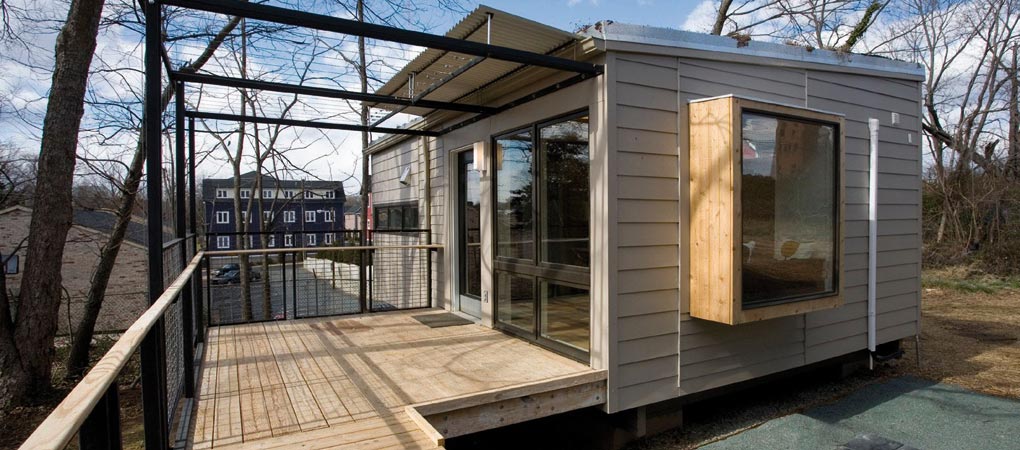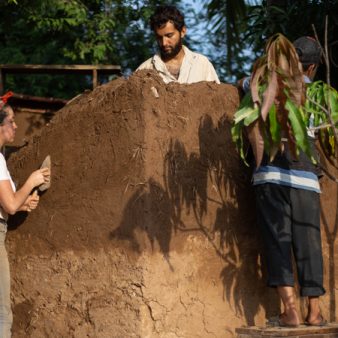This design / build / evaluate project based at the University of Virginia enables students from a variety of disciplines to gain hands-on, real-world experience working in collaboration with social housing providers to deliver innovative, environmentally-sustainable prefabricated housing for low-income households. Currently in its fourth cycle, over 300 students have participated in the programme working closely with industry professionals to design and build five near-zero energy homes. Many have gone on to take key positions in organisations working to deliver housing that is both affordable and sustainable. Work is currently underway to take ecoMOD designs into production in order to give housing providers low-cost, immediate and sustainable options with reduced operating costs.
Project Description
Aims and Objectives
The aim of ecoMOD is to provide an interdisciplinary, hands-on educational experience to train the next generation of building and construction professionals. By demonstrating the environmental and economic potential of sustainable prefabrication, the project hopes to challenge the housing industry in the US to further explore this sector.
Project Context
The ecoMOD project addresses the growing lack of affordable housing in the US and the enormous environmental impact from the construction and operation of conventional residential buildings. The increase in both property prices and income disparity in the country has deeply affected the ability of low to moderate income Americans to save enough money to purchase a home. This has been exacerbated by the mortgage and credit market crisis in 2008.
According to the Joint Centre for Housing Studies, almost one in seven Americans are “severely housing cost-burdened,” defined as those who are spending more than 50 per cent of their income on housing costs. Buildings produce almost half of US greenhouse gas emissions, harming the environment more than any other sector of the US economy. Sustainably designed homes in the US have until now been built mostly for those with high and middle incomes. Currently, prefabricated homes are seldom designed for energy efficiency, and most sustainable houses are expensive to build. The history of prefabricated housing is one with many ‘visionary’ designs by notable architects that never made it beyond the studio or prototype. By 2030 over half of the buildings that exist in the US will have been built since 2000. Many of the necessary strategies and technologies already exist to create (or renovate) this next generation of housing. Therefore it is especially important to properly educate the next generation of building professionals in how to use them appropriately.

Key features
ecoMOD is an inter-disciplinary design/build/evaluate project based at the University of Virginia (UVA) and is a hands-on training initiative that involves ‘real buildings’ with ‘real budgets’. The project is a partnership between the UVA School of Architecture and the UVA School of Engineering and Applied Science, and it is fully integrated into the curriculum of the university. Since 2004, over 300 students and faculty of architecture, engineering, landscape architecture, planning, historic preservation, economics, environmental science, environmental thought and business have participated in various phases of the project.
ecoMOD works through building near-zero-energy homes that both reduce utility costs and address the global environmental crisis. By partnering with non-profit organisations and with prefabricated housing builders, ecoMOD hopes to help affordable housing organisations leverage the financial advantages of prefabricated construction with homes built to a LEED for Homes platinum standard.
Over the course of three project cycles since 2004, ecoMOD teams have built a total of five sustainable, prefabricated housing units for Piedmont Housing Alliance (PHA) and Habitat for Humanity (HFH), and are currently working on a sixth (ecoMOD4). The housing units are designed and built by interdisciplinary teams of students, working closely with faculty and outside experts. After the homes are occupied, student teams monitor and evaluate them carefully, with the results guiding subsequent designs.
The previous ecoMOD phases have included:
- ecoMOD1, a two-unit condominium for PHA (a 136m2 three-bedroom unit and 68m2 studio apartment) in Charlottesville, Virginia at a cost of US$1,227/m2 (total cost US$250,000).
- ecoMOD2, a 110m2 single-family, detached, three-bedroom home for HFH in Gautier, Mississippi following Hurricane Katrina, at a cost of approximately US$753/m2 (total cost US$82,850).
- ecoMOD3, a 97m2 historic preservation of a former slave quarters (two-bedroom plus guest loft) for PHA at a cost of US$2,690/m2 (total cost US$261,000) and a 38m2 studio apartment rental unit registered with US Green Building Council’s LEED for Homes Pilot Phase (Platinum certificate pending) at a cost of US$1,313/m2 (total cost US$50,000). The site is in Charlottesville, Virginia.
- ecoMOD4, a 92m2 single-family, detached, two-bedroom home for HFH in Charlottesville at a cost of US$150,000.
Each ecoMOD housing unit uses a high-performance building envelope to minimise the need for mechanical heating and cooling, as well as low environmental-impact materials and highly energy-efficient systems, equipment and appliances. In addition, each individual ecoMOD team typically selects one or two sustainable features that go beyond what could be expected in an affordable housing budget, and the team directly raises the money to implement them. These ‘eco upgrades’ have included a photovoltaic solar array, a potable rainwater collection system, and green roofs. The ‘evaluating ecoMOD’ process uses emerging strategies and protocols for the analysis of a completed building. Each evaluation process may include both qualitative and quantitative analysis into the environmental impact of the systems and materials; energy performance; affordability; human comfort; constructability; and thoughtful placement within a community.
Covering costs
Each cycle of the project has required between US$50,000 and US$120,000 to cover the cost of the ecoMOD fabrication facility; tools, equipment and software; student fellowships; staff costs; field trips and monitoring equipment for the evaluation phase. These costs were met by a range of funding sources including:
- An initial start-up grant of US$268,000 from an anonymous local foundation.
- U.S. Environmental Protection Agency (US$10,000 through their P3 Award program).
- National Council of Architectural Registration Boards (US$25,000 for receiving their 2007 Grand Prize).
- In-kind or indirect funding including support of time or resources from builders, architects and engineers.
- The Conservation Fund’s Go Zero program provided in-kind support for carbon offsets of ecoMOD3.
- UVA has directly funded the project with internal grants totalling over US$35,000 from the UVA Institute on Aging, the UVA Community Engagement Initiative, and the UVA Teaching and Technology Initiative.
- Indirect funding comes from UVA in the form of faculty and staff salaries; classroom, studio and laboratory space; and the technical infrastructure to support the project.
ecoMOD receives construction funding from its partner housing organisations (PHA or HFH), each project being built to the same budget that the partner organisation would use to construct a similar size home. For PHA, the costs are generally around US$1,345/m2 for new construction (ecoMOD3 incorporated the historic renovation of a house requiring completely new foundations, plumbing, electrical wiring etc, and this is reflected in the increased cost). For HFH, the costs range from US$700/m2 to US$1,185/m2 the project has received ‘green upgrade’ funding or discounts for each ecoMOD project cycle from a range of sources – typically between US$15,000 and US$20,000 per project. depending on size and location.
Impact
The individual homeowners benefit significantly from the reduced utility bills of their homes, and from the opportunity to live in a well-built home they can afford. The residents are enthusiastic about and proud of their home.
The project has a significant impact on the students’ chosen career direction and this will feed through into the American construction system in the coming years. Over 50 of the 300 participants have gone on to have careers in affordable housing, sustainable design and/or prefabrication and of the 24 students taking graduate degree courses, 22 are pursuing these themes.
The number of enquiries from prefabricated housing builders and affordable housing organisations, regarding purchase of the designs, has been increasing month on month. The ecoMOD3 and ecoMOD4 designs have been designed for multi-family housing in addition to single family detached, and affordable housing authorities and organizations in Virginia are currently considering having modular builders develop the housing units for them. The take-up of the designs in the future will be a key indicator.
Why is it innovative?
- The ground-breaking, inter-disciplinary project is now an established part of the UVA curriculum offering real-world opportunities for students to train and prepare for the future challenges they will face as builders and designers.
- The housing units themselves include many innovative design features, compared to both conventional prefabricated buildings and to standard affordable housing.
- The ecoMOD systems can be adjusted to climate and site, and implemented as urban infill. The landscape designs confront local storm-water situations and ecosystems.
- The design and build process makes use of rigorous standards for environmental decisions. ‘Design for deconstruction’ and energy-saving strategies are used extensively and natural day-lighting/ventilation help generate the form of the buildings.
- There is a strong emphasis on a thorough evaluation of the affordability and environmental impact. The next generation of the ecoMOD monitoring system will give occupants feedback on operation of the building and the hope is to license and/or commercialise the final ecoMOD wireless building monitoring system to make it available to other affordable housing organisations.
What is the environmental impact?
Whilst the main focus of the project is the process rather than the individual houses, ecoMOD creates site-specific homes, using natural lighting and ventilation, non-hazardous materials, renewable energy, and energy-efficient systems to help reduce environmental impact and improve occupant health. The project seeks to develop and implement technologies that lead to a more appropriate use of water and energy. Examples of this to date include:
- ecoMOD1 features include a potable rainwater collection system (the first in the city), a solar hot water panel and sustainably forested wood flooring. Monitoring shows that the two occupants are using 50 per cent less energy than occupants in a comparable home.
- ecoMOD2 incorporates a photovoltaic solar panel array and a heat pump/heat recovery system to provide domestic hot water. The design can be pre-fabricated as panels, modules, or both. The house is built from an innovative steel and foam panel system (‘Thermasteel’) which is highly energy-efficient, and resists hurricane force winds, as well as mould.
- ecoMOD3’s design features include an evacuated tube solar hot water system coupled with on-demand water heating, a modular green roof system and ‘ThermaSteel’ wall panel construction. ecoMOD3 complies with EarthCraft and LEED for Homes sustainability criteria. Under LEED, it is expected that the studio apartment rental unit will achieve the highest Platinum level certification. ecoMOD3 is a renovation project that uses reclaimed and recycled building materials. Broken down into a modular ‘kit-of-parts’, the system maximises efficiency through modular consistency, a variety of insertions within those modules, and is site responsive, minimising the disturbance to existing construction.
- ecoMOD4’s design is the closest to net-zero energy usage. It includes a superinsulated building envelope; geothermal heating and cooling system; and photovoltaic array. It is registered with the LEED for Homes program and targeting Gold or Platinum certification. It will be complete in the fall of 2009.
Is it financially sustainable?
The project overheads are met by a combination of UVA funding and foundation grants. The high level of recognition suggests this will continue. The UVA Patent Foundation has registered the copyright for each of the completed designs so far, and has licensed the designs to a company looking to market the designs to affordable housing organisations, prefabricated housing builders and individuals hoping to create a small revenue stream to help offset the overhead costs. Prefabricated housing builders have said they could replicate the designs for between eight and 15 per cent less than the cost that ecoMOD can currently build them for.
One of the central aims of the project is to address the housing affordability crisis in the US and the project aims to show that prefabricated housing is a legitimate strategy for urban areas through the careful design of modules to allow easy transportation and placement. ecoMOD’s work with HFH and PHA helps ensure that the housing needs of their low-income clients are met and the ecoMOD housing is produced at the same cost as the partner organisations would normally construct. Both HFH and PHA are interested in further uptake of the work and continue to support ecoMOD.
The students involved in ecoMOD not only have their UVA qualification but have real-world experience of approaches to housing that seek to tackle the dual challenge of affordability and environmental impact, skills which will serve them well in the future.
What is the social impact?
The students and the partner non-profit housing organisations have learnt a great deal through the ecoMOD process. In many instances the technology and strategies to develop affordable, sustainable housing exist, but this project seeks to ensure that designers and builders understand and use them appropriately. Students have gone on to take positions in key organisations involved in affordable housing and sustainable design.
By building in existing urban areas, not only is the household’s carbon footprint reduced, but also its ability to be well-integrated into a local community is enhanced. Each of the ecoMOD projects in Charlottesville is located on a previously developed infill site and within walking distance of stores and public transport. A major focus is community outreach, mostly in the context of the low- to moderate-income neighbourhoods where the homes are located. The students attend neighbourhood association meetings, to get a sense of the concerns in the area, and then later to present the designs for feedback.
All the ecoMOD projects work to develop housing suitable for a low-income household’s needs. As a result of the project, PHA and HFH client households have a secure, energy-efficient house in which to live. All designs place an emphasis on day-lighting and ventilation and use interior materials containing low- or non-volatile organic compounds (found in paints, varnishes, sealants and primers) for an improved living environment. ecoMOD3 addresses housing needs for older persons so that they can ‘age in place’. This is done through the use of a modular system that can be added if the need to house care givers arises. ecoMOD2, ecoMOD3 and ecoMOD4 follow the Americans with Disability Act (ADA) accessibility guidelines as well as broader strategies for Universal Design.
Barriers
- Resistance from other university faculties, questioning the academic value of the interdisciplinary project was overcome through persistence and success.
- The difficulty of raising money in the current economic climate.
- The conservative nature of the prefabricated housing industry limited the ability of prefabricated housing builders to seriously consider the designs. Ironically, the current housing slump has made it easier for prefabricated housing builders to consider ecoMOD designs, since an economic downturn is a good time to re-envision a housing company.
- Delays in construction led to problems in delivering the evaluation stage. The project was initially organised as a cyclical process of one academic year for design, a summer of construction, and an academic year of evaluation. However, the build and evaluation phases have begun to overlap.
Lessons Learned
- Keep the design simple but adaptable and flexible.
- Test the designs on various sites to ensure they can respond to differing site contexts.
- A high-performance building skin (a lot of insulation with durable finishes) is money well spent.
- Keep the house as small as possible, but slightly higher ceilings and subtle architectural manipulations can make rooms feel larger.
- Collaborative teams are hard to manage – give each member of the team a voice, and something they can directly impact, and the collaboration goes much more smoothly.
- Always speak with clients about life cycle costs, not just the initial costs of construction.
- To ensure successful passive design, it is best to imagine the home will have no electrical power at all.
- Occupants need to be personally trained to understand any strategies or technologies that are unfamiliar.
- Innovative systems are best procured from installers that will offer a warranty.
- The most important lessons are the ones gathered from evaluating the building and listening to the occupants.
Evaluation
Evaluation is a key component of the project. The project is structured to monitor and analyse each completed prototypical housing unit by assessing its environmental impact, efficiency, affordability, occupant satisfaction, and production readiness. The monitoring systems designed by the ecoMOD engineering teams measure indoor and outdoor air temperature, relative humidity, CO2 levels, and electricity, gas, and water usage.
Transfer
The UVA Patent Foundation and the UVA Economic Development Office are helping ecoMOD to bring the designs to the market by registering the copyrights for the drawings of the completed homes. They have also licensed the designs to a modular marketing company to make them available to modular builders, individuals and affordable housing providers. By taking the ecoMOD designs into production, the intention is to give affordable housing organisations quick, low-cost and sustainable infill housing options that cost less to operate.
In addition to the built version of ecoMOD4 as a single family home, HFH will consider using the same design deployed as townhouses on three other sites in the city of Charlottesville. A prefabricated housing builder will build these versions. PHA has now pursued prefabricated construction for three single-family detached homes, and a large multi-family project as a direct result of their involvement with ecoMOD. In addition, they have begun to significantly broaden the range of sustainable design strategies, materials and technologies that they will consider for their projects.
There are several examples of ecoMOD strategies and ideas being directly applied at other universities, including Mississippi State, Cornell, University of Texas at Austin, Ohio State University, University of Arkansas, and Catholic University of America, as well as the development of a green building program at Charlottesville Albemarle Technical Education Centre, the vocational education partner for ecoMOD3.



